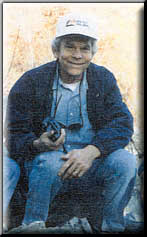Quest For A Cure
Years ago, John Sterling did Intelligence and Reconnaissance for the U.S. Army. Now he does it for himself, in his own battle with mesothelioma.
Besides serving in the Army, Mr. Sterling had served in the Merchant Marines as a boiler tender, worked in factories as a maintenance millwright and maintenance supervisor, and later, with his wife, Peggy, started a successful in-home business. He was very healthy, and never sick. In the 1980's, he ran 8 and one-half miles a day and later became an avid brisk walker. Last winter, he and one of his two daughters, Bonnie, went skiing, and Bonnie says he skied better than she did.
But in April, 2000, Mr. Sterling began experiencing a dry, hacking cough, and had to give up walking. He met with his family physician who prescribed a generic cough medicine. The coughing continued, and in June he began also experiencing shortness of breath upon increased activity or moderate exercise. To sleep without coughing or shortness of breath he had to lay on his left side.
Then one day, in a simple act of bending over, Mr. Sterling became extremely short of breath. He went back to the doctor and had several chest films taken. These showed a large left pleural effusion. A CAT scan confirmed the effusion, with compression of the left lower lung. On July 3, a pulmonologist performed a thoracentesis, removing 3 liters of yellow/clear fluid. The fluid tested as nonmalignant. In just over another week, Mr. Sterling had fluid build up again. On July 13, he underwent a second thoracentesis and also a pleural biopsy. The biopsy showed "reactive mesothelial cells."
On July 25, the pulmonologist performed a fiberoptic bronchoscope, and brush biopsy of the lingula and lower lobe bronchi. The cytology of the fluid returned a suspicion of adenocarcinoma. The brushings were suspicious of non-small cell carcinoma. On August 15, Mr. Sterling underwent a thoracostomy with biopsy, a thoracentesis and a successful talc pleurodesis. This time, the cytology returned a diagnosis consistent with mesothelioma. The pathology report diagnosed malignant, diffuse mesothelioma with an epithelial cell type.
Due to the extensiveness of the disease on the pleura and persistent pleural drainage (despite talc), Mr. Sterling's doctor decided to put in a Heimlich valve and foley bag so Mr. Sterling would have a chronic relief of his dyspnea (shortness of breath). In his discharge report, the doctor stated, "I do not think that we can get this tube out given the nature of his disease." Approximately 3 and a half weeks later the tube was removed successfully and at this time is unnecessary.

Based on the mesothelioma diagnosis, Mr. Sterling's local doctors referred him to the University of Pennsylvania, and he got an appointment there for August 30. About this time, Mr. Sterling's daughter, Bonnie, hit the internet, and soon found MARF. Mr. Sterling and his family were pleased to learn that Dr. Larry Kaiser and Dr. Steven Hahn, both at UPENN, were on MARF's Science Advisory Board.
They were also pleased and relieved to learn through MARF that the grim statistics they had been hearing and reading about were not the whole story. Experts were working on the disease, and innovative treatments were being tested and made available. Mr. Sterling and his family could review various treatment options, interview mesothelioma experts, gather information and make decisions about his treatment. Knowledge is power. Though he still struggles emotionally sometimes, realizing the importance of his own role in his treatment has helped Mr. Sterling's attitude. Whereas when he was first diagnosed, he felt like it was a death sentence; now, he feels positive and is ready to do whatever he has to do to fight the disease.
On August 30, Mr. Sterling and his wife met the mesothelioma team at the University of Pennsylvania to discuss his treatment strategy. The doctors described their preferred procedure, an extra-pleural pneumonectomy followed by use of the drug Foscan and photo dynamic laser treatments. Mr. Sterling credits the UPENN doctors for being very straightforward with him about the procedure and the risks.
While awaiting the test results which would determine if he was a candidate for this surgery, Mr. Sterling continued to explore other options. He learned of the clinical trial in San Antonio using the investigational anticancer drug called Ely Lilly LY231514 (Multi-Targeted Antifolate or ALIMTA (R) (pemetrexed disodium)). Mr. Sterling was hesitant to undergo radical surgery, so this presented an attractive option. The UPENN doctors assured him that having the ALIMTA chemotherapy would not exclude him from surgery later. Through his attorneys, RGW P.C., and his doctors at UPENN, Mr. Sterling was able to contact the administrator of the ALIMTA trial. He was accepted into the ALIMTA trial, so he has elected to pursue it. His first treatment will begin November 14, 2000.
*** POSTED NOVEMBER 6, 2000 ***
An Update -- 2/6/01
Mr. Sterling is traveling to San Antonio for his 5th treatment on February 7. He is to receive a combination of CPT11 and ALIMTA. He feels like the treatments are "working", but he is experiencing a loss of appetite from them as well as feeling very tired.
Mr. John Sterling passed away on January 16, 2003


